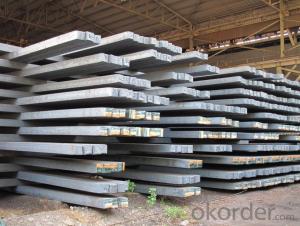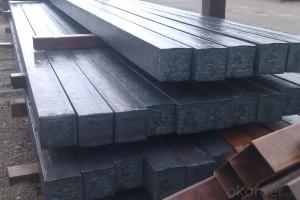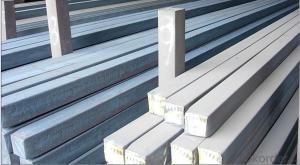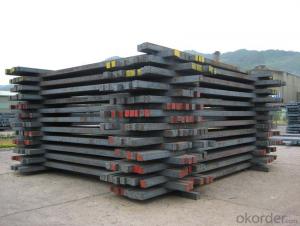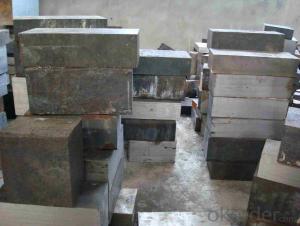Hot Rolled Square Steel Billet 3SP Standard 125mm
- Loading Port:
- Shanghai
- Payment Terms:
- TT OR LC
- Min Order Qty:
- 2000 m.t.
- Supply Capability:
- 10000 m.t./month
OKorder Service Pledge
OKorder Financial Service
You Might Also Like
Structure of Hot Rolled Square Steel Billet 3SP Standard 125mm

Description of Hot Rolled Square Steel Billet 3SP Standard 125mm
PPGI is made by cold rolled steel sheet and galvanized steel sheets as baseplate, through the surface pretreatment (degreasing, cleaning, chemical conversion processing), coated by the method of continuous coatings (roller coating method),
and after roasting and cooling. Zinc coating: Z60, Z80, Z100, Z120, Z180, Z275, G30, G60, G90
Alu-zinc coating: AZ60, AZ80, AZ100, AZ120, AZ180, G30, G60, G90
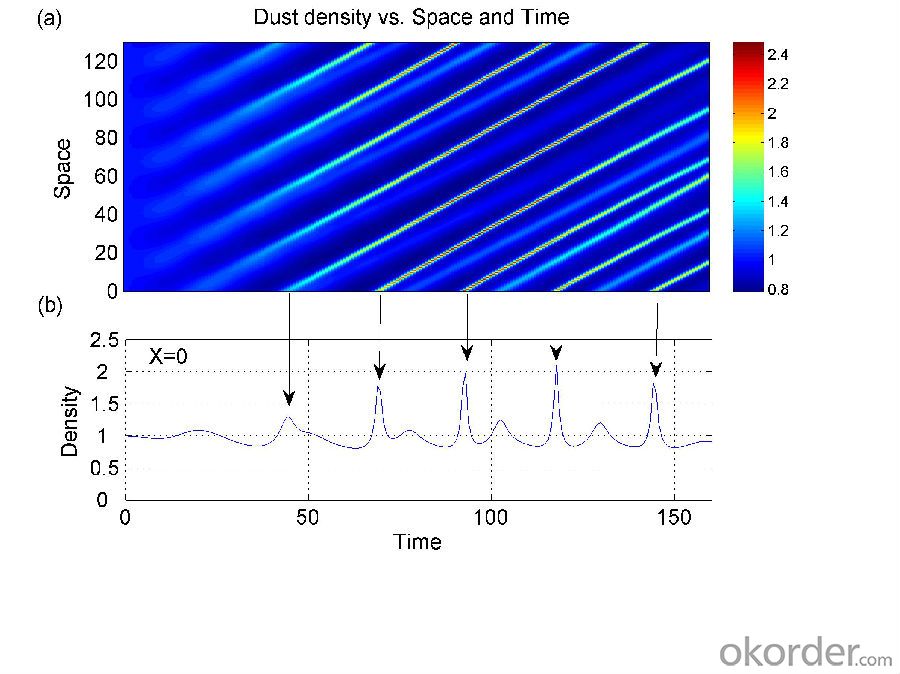
Main Feature of Hot Rolled Square Steel Billet 3SP Standard 125mm
1) Excellent corrosion resistance: The zinc layer provides a good protection of Pre-painted Galvanizeed Steel Sheet.
2) High heat resistance: The reflective surface of the material aids in efficiently reflecting the sunlight away and in turn reducing the amount of heat transmitted. The thermal reflectivity converts into energy savings.
3) Aesthetics: Pre-Painted Galvanized steel sheet is available in plethora of patterns and multiple sizes as per the requirements that given by our customers.
4) Versatility: can be used in the various areas.Standard seaworthy export packing: 3 layers of packing, inside is kraft paper, water plastic film is in the middle and outside GI steel sheet to be covered by steel strips with lock, with inner coil sleeve.
Applications of Hot Rolled Square Steel Billet 3SP Standard 125mm
1) Automotive bodies: filters, fuel tanks, etc.
2) Construction materials: roofings, welding pipes,
3) Electric and electronic appliances: computer cans, etc.
4) Steel cans: containers, etc.
5) Steel furniture: washing machines, refrigerators, microwaves, etc.
6) Drums
7) Office equipment: printer, recorders, etc.
8) Motors and transformers

Specifications of Hot Rolled Square Steel Billet 3SP Standard 125mm
| Classified symbol | Yield Point Minimum N/mm2 | Tensile Strength Minimum | Elongation Minimum % | Application | ||||
| N/mm2 | Nominal Thickness mm (t) | |||||||
| JIS | Yogic | 0.25-0.4 | 0.4-0.6 | 0.6-1.0 | 1.0-1.6 | |||
| G3312 | specification | |||||||
| CGCC | CGCC | -205 | -270 | -20 | -21 | -24 | -24 | Commercial |
| CGCD | CGCD | --- | 270 | --- | 27 | 31 | 32 | Drawing |
| --- | CG340 | 245 | 340 | 20 | 20 | 20 | 20 | Structural |
| CGC400 | CG400 | 295 | 400 | 16 | 17 | 18 | 18 | Structural |
| CGC440 | CG440 | 335 | 440 | 14 | 15 | 16 | 18 | Structural |
| CGC490 | CG490 | 365 | 490 | 12 | 13 | 14 | 16 | Structural |
| CGC570 | CG570 | 560 | 570 | --- | --- | --- | --- | Structural |
| ASTM Designation | Yield Point Minimum | Tensile Strength Minimum | Elongation Minimum % | Application | Q/BQB 445-2004(China standard) | ASM A653/A653M | JISG 3312 | |
| ksi(MPa) | ksi(MPa) | TDC51D+Z | (CS TYPE A+Z) | CGCC | ||||
| A653(M)-99 CS TYPE A,B,C | --- | --- | --- | Commercial | TDC52D+Z | CGCD | ||
| A653(M)-99 FS | --- | --- | --- | Lock Forming | TS250GD+Z | (G250+Z) | - | |
| A653(M)-99 DS | --- | --- | --- | Drawing | TS300GS+Z | (G300+Z) | CGC 400 | |
| A653(M)-99 SS Grade33(230) | 33(230) | 45(310) | 20 | Structural | TS350GD+Z | (G350+Z) | CGC490 | |
| A653(M)-99 SS Grade37(255) | 37(255) | 52(360) | 18 | Structural | TS550GD+Z | (G550+Z) | CGC570 | |
| A653(M)-99 SS Grade40(275) | 40(275) | 55(380) | 16 | Structural | ||||
| A653(M)-99 SS Grade50(345) | 50(345) | 65(450) | 12 | Structural | ||||
| A653(M)-99 SS Grade80(550) | 80(550) | 82(570) | --- | Structural | ||||
FAQ of Hot Rolled Square Steel Billet 3SP Standard 125mm
We have organized several common questions for our clients,may help you sincerely:
1. How Can I Visit There?
Our company is located in Tianjin City, China, near Beijing. You can fly to Tianjin Airport Directly. All our clients, from home or aboard, are warmly welcome to visit us!
2. How Can I Get Some Sample?
We are honored to offer you sample.
3. Why choose CNBM?
1, ISO, BV, CE, SGS approved.
2, Competitive price and quality.
3, Efficient service team online for 24 hours.
4, Smooth production ability(50000tons/month) .
5, quick delivery and standard exporting package.
6, Flexible payment with T/T, L/C, Paypal, Kunlun bank, etc.
- Q:What is the role of steel billets in the construction of underground tunnels?
- The construction of underground tunnels heavily relies on steel billets, which are cylindrical steel bars. These bars act as the primary raw material for manufacturing various structural components that are crucial in guaranteeing the stability and safety of the tunnel. One significant use of steel billets is in the production of rebar, also known as reinforcing bar. Rebars are inserted into the concrete walls and floors of the tunnel to provide tensile strength and prevent cracking or collapsing under the immense pressure exerted by the surrounding soil or water. These steel bars reinforce the concrete, making it more durable and resistant to deformation, ultimately enhancing the overall structural integrity of the tunnel. Moreover, steel billets are also utilized to create other essential tunnel components, including tunnel segments and steel arches. Tunnel segments are precast concrete elements that form the lining of the tunnel, often incorporating steel reinforcement for added strength. On the other hand, steel arches are employed in constructing tunnel roofs to offer extra support and stability. Additionally, steel billets are employed in the fabrication of various tunnel reinforcement systems like rock bolts and ground anchors. These systems help secure loose or unstable rock formations, preventing them from collapsing and jeopardizing the stability of the tunnel. Steel billets are also used in manufacturing tunnel supports such as steel ribs and beams, which provide additional strength and rigidity to the tunnel structure. In conclusion, steel billets are critical in the construction of underground tunnels. By being transformed into rebar, tunnel segments, steel arches, and reinforcement systems, they play a vital role in ensuring the structural integrity, stability, and safety of tunnels, ultimately facilitating efficient and secure transportation networks underground.
- Q:What are the specifications for stainless steel billets used in the marine industry?
- The specifications for stainless steel billets used in the marine industry typically include a specific grade of stainless steel, such as 316 or 316L, which offers excellent corrosion resistance in marine environments. These billets are often required to meet certain standards, such as ASTM A276 or ASTM A484, which outline the chemical composition, mechanical properties, and dimensional tolerances for stainless steel products. Additionally, the billets may need to undergo specific heat treatment processes, such as annealing or solution treatment, to ensure optimal strength and corrosion resistance.
- Q:What are the different types of steel billet forging machines?
- There are several different types of steel billet forging machines, including mechanical presses, hydraulic presses, screw presses, and hammer forging machines. Each type of machine has its own unique characteristics and capabilities, allowing for the efficient and precise forging of steel billets into desired shapes and sizes.
- Q:What are the different types of steel billet reheating furnaces?
- There are several different types of steel billet reheating furnaces used in the metal industry. These furnaces are designed to heat steel billets to a specific temperature before they are further processed or shaped into various end products. The main types of steel billet reheating furnaces include: 1. Pusher Type Furnace: This type of furnace uses a pusher mechanism to move the billets through the furnace. The billets are loaded onto a roller conveyor and pushed into the furnace using mechanical pusher plates. As the billets move through the furnace, they are heated by the combustion gases or electrical heating elements. 2. Walking Beam Furnace: In a walking beam furnace, the billets are placed on a series of moving beams or skids. These beams move in a continuous loop, carrying the billets through the furnace. As the billets move, they are heated by the burners or electrical heating elements located above and below the beams. 3. Rotary Hearth Furnace: This type of furnace consists of a rotating hearth on which the billets are placed. The hearth rotates, bringing the billets through different temperature zones within the furnace. The billets are heated by the burners or electrical heating elements located above the hearth. 4. Continuous Furnace: A continuous furnace is a type of furnace where the billets are continuously fed into one end and discharged from the other end. The billets move through the furnace on a conveyor belt or roller conveyor, being heated by the combustion gases or electrical heating elements as they pass through. 5. Walking Hearth Furnace: In a walking hearth furnace, the billets are placed on a hearth that moves in a reciprocating motion. The hearth moves back and forth, bringing the billets through the furnace. The billets are heated by the burners or electrical heating elements located above and below the hearth. Each type of steel billet reheating furnace has its own advantages and is suitable for specific applications. The choice of furnace depends on factors such as the required heating capacity, the size and shape of the billets, the desired temperature profile, and the energy efficiency requirements.
- Q:How are steel billets used in the production of automotive steering systems?
- Automotive steering systems rely heavily on steel billets, a crucial element in their manufacturing. These billets, typically crafted from high-quality steel, serve as the raw material for producing various steering system components like shafts, gears, and housings. The production process begins by heating and softening the steel billets to increase their malleability. This allows them to be easily molded and shaped into the desired steering system components through methods such as forging, rolling, or casting. The chosen technique depends on the complexity and function of the component being manufactured. Once the desired shape is achieved, the steel billets undergo further processing to enhance their strength and durability. This involves employing heat treatment techniques like quenching and tempering, which provide the steel with specific mechanical properties like improved hardness and toughness. These treatments ensure that the steering system components can handle the considerable loads and vibrations experienced during operation. After proper shaping and treatment, the billets undergo precision machining processes to attain the required dimensional accuracy and surface finish. This includes cutting, drilling, and grinding the billets to create the necessary profiles and features that enable optimal functioning within the steering system. Lastly, the finished steering system components are assembled together with other parts to create the complete automotive steering system. These components, manufactured from steel billets, play a critical role in transmitting driver input to the wheels, enabling precise control and maneuverability of the vehicle. In summary, steel billets are indispensable in the production of automotive steering systems as they provide the necessary strength, durability, and precision required for safe and efficient vehicle steering.
- Q:How do steel billets contribute to the manufacturing of water and wastewater treatment equipment?
- Steel billets play a crucial role in the manufacturing of water and wastewater treatment equipment. These billets are essentially semi-finished steel products that are used as raw materials for various industrial applications. When it comes to the water and wastewater treatment industry, steel billets are utilized in the production of key components such as tanks, pipes, valves, and pumps. One of the primary reasons steel billets are favored in this industry is due to their excellent strength and durability. Water and wastewater treatment equipment are subjected to harsh operating conditions, including exposure to corrosive chemicals, high pressure, and extreme temperatures. Steel billets, made from high-quality materials such as carbon steel or stainless steel, offer the necessary strength and resistance to withstand these demanding environments. Furthermore, steel billets can be easily fabricated and formed into different shapes and sizes, making them highly versatile for manufacturing water and wastewater treatment equipment. These billets can be forged, rolled, or extruded to create components with precise specifications, ensuring a perfect fit and optimal functionality. The corrosion resistance of stainless steel billets is particularly valuable in water and wastewater treatment equipment. These billets are highly resistant to rust and corrosion, preventing contamination of the water supply and ensuring the longevity of the equipment. Stainless steel billets are also hygienic, making them suitable for applications where maintaining water quality and cleanliness is of utmost importance. Additionally, steel billets offer cost-effectiveness in the manufacturing process. The abundance of steel as a material and its recyclability make it a cost-efficient choice for producing water and wastewater treatment equipment. The long lifespan of steel components also reduces the need for frequent replacements, resulting in lower maintenance and operational costs. In summary, steel billets are essential in the manufacturing of water and wastewater treatment equipment due to their strength, durability, versatility, corrosion resistance, and cost-effectiveness. These billets provide the necessary raw materials to create robust and reliable components that can withstand the challenging conditions of the water treatment industry.
- Q:Can steel billets be used in the production of sculptures and artwork?
- Sculptures and artwork can indeed utilize steel billets. Steel, being a versatile and malleable material, empowers artists to fashion one-of-a-kind and intricate designs. The inclusion of steel billets in sculptures and artwork guarantees sturdiness, resilience, and the potential for expansive installations. Artists can skillfully mold, fuse, and manipulate steel billets to generate an extensive array of sculptures, ranging from abstract shapes to figurative representations. The utilization of steel also contributes a contemporary and audacious touch to the artwork, thanks to its industrial aesthetic. Moreover, artists can opt to employ diverse techniques such as painting, patina, or polishing to further enrich their creative vision. In summary, steel billets present an exhilarating prospect for artists to delve into and stretch the boundaries of their artistic expression.
- Q:How are steel billets used in the production of power transmission equipment?
- Steel billets are an essential component in the production of power transmission equipment. Power transmission equipment, such as gears, shafts, and couplings, require high-strength and durable materials to withstand the forces and stresses involved in transmitting power. Steel billets, which are semi-finished steel products, play a crucial role in meeting these requirements. Firstly, steel billets are used as raw material for forging or casting processes to create various components of power transmission equipment. Forging involves heating the billets to a high temperature and then shaping them under extreme pressure, resulting in a strong and dense material with excellent mechanical properties. Casting, on the other hand, involves pouring molten steel into molds to form complex shapes. Steel billets are melted and cast into molds to create intricate components like gears or shafts. Furthermore, the composition and quality of steel billets are carefully controlled to ensure that the final product meets the specific requirements of power transmission equipment. Steel billets are made from various steel grades, each with different properties such as strength, hardness, and wear resistance. The choice of steel grade depends on the specific application and operating conditions of the power transmission equipment. For instance, a gear used in heavy-duty industrial machinery may require a higher strength steel billet compared to a gear used in a smaller-scale application. Additionally, steel billets can undergo further processing, such as heat treatment, to enhance their mechanical properties. Heat treatment processes like quenching and tempering can improve the hardness, toughness, and overall performance of the billets. This ensures that the final power transmission equipment has the necessary strength and durability to withstand the rigors of transmitting power. In summary, steel billets are crucial in the production of power transmission equipment due to their strength, durability, and versatility. They serve as raw material for forging or casting processes, allowing the creation of complex components. The careful selection of steel grade and heat treatment processes ensure that the final product meets the specific requirements of power transmission equipment, making steel billets an integral part of the manufacturing process.
- Q:What is the size and shape of steel billets?
- The intended use of steel billets determines their sizes and shapes, which can vary. Typically, they have a rectangular form and their dimensions can range from small to large. The length can vary from several inches to several feet, while the width and height can adjust accordingly. These measurements are determined by the specific needs of the steel manufacturing process and the desired final product. Furthermore, steel billets can be customized to meet specific production requirements, such as square or round shapes.
- Q:What is the purpose of steel billets?
- Steel billets have a vital role in the steel manufacturing industry, as they act as the primary material for producing a range of steel products. These billets are semi-finished goods that usually have a square or rectangular shape, and they are created through the casting or hot rolling process. Once formed, these billets undergo further processing, including forging, rolling, or extrusion, to manufacture finished steel products such as bars, rods, wire, pipes, and tubes. The significance of steel billets lies in their ability to provide a consistent and uniform starting material that can be easily molded and shaped into various products. With desirable qualities like strength, durability, and ductility, these billets are well-suited for applications in construction, automotive, infrastructure, machinery, and many other industries. By utilizing steel billets, manufacturers can efficiently produce steel products with precise dimensions, mechanical properties, and surface finishes. By controlling the composition and processing techniques of the billets, steel manufacturers can customize the final product to meet specific customer requirements, ensuring optimal performance and quality. In conclusion, steel billets serve as the foundation for manufacturing various steel products. They play a crucial role in shaping and forming steel into the desired finished products, enabling industries to effectively meet the diverse needs of modern society.
1. Manufacturer Overview |
|
|---|---|
| Location | |
| Year Established | |
| Annual Output Value | |
| Main Markets | |
| Company Certifications | |
2. Manufacturer Certificates |
|
|---|---|
| a) Certification Name | |
| Range | |
| Reference | |
| Validity Period | |
3. Manufacturer Capability |
|
|---|---|
| a)Trade Capacity | |
| Nearest Port | |
| Export Percentage | |
| No.of Employees in Trade Department | |
| Language Spoken: | |
| b)Factory Information | |
| Factory Size: | |
| No. of Production Lines | |
| Contract Manufacturing | |
| Product Price Range | |
Send your message to us
Hot Rolled Square Steel Billet 3SP Standard 125mm
- Loading Port:
- Shanghai
- Payment Terms:
- TT OR LC
- Min Order Qty:
- 2000 m.t.
- Supply Capability:
- 10000 m.t./month
OKorder Service Pledge
OKorder Financial Service
Similar products
New products
Hot products
Related keywords
